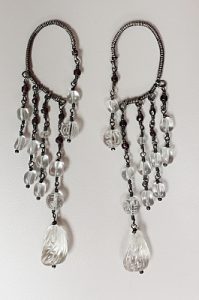Artisans make bread-n-butter pieces: smaller, simpler objects that feed the bank account. But they also need room for the big or complicated gonzo works that feed their joy and skill.
I don’t have pierced ears, I don’t intend to ever have pierced ears, and clip-on earrings tend to hurt me after about an hour. So when I design jewelry I tend not even consider making earrings. (I’m all about ear cuffs, however, which are usually absurd and overblown.)

For 2018, I’m trying more earring designs. They’re small and generally less tricky to do than a big necklace project. They make a good test of new stitches and bead types. Because they take less time and material, they can be more affordable for both artist and buyer.
I love painting on matte-finished shell, but I need more practice to get my knack back. Hence: earrings.
A few of my beading friends make the bulk of their show and Etsy income from earrings. For various reasons I need to follow in their footsteps this year.
But earrings (and beaded amulet bags, bracelets, barrettes, and other small projects) have a hidden cost: the time and material spent making them is lost from bigger, more ambitious projects. There can be a strong temptation to *only* make earrings to sell. This same tendency befalls many Etsy artisans and artists attempting to load juried festival booths with cheaper buy-sell goods. Cheap and fast = lots of small sales. Especially in a recession.
What do artists lose when they focus solely upon easy sales targets? They can’t build up stocks of larger and/or involved gallery-and-museum-worthy pieces. That robs them of the opportunity to enter career-advancing contests, or apply for single-person gallery retrospectives. Unless those artists run across an earring-only gallery, they’re out of luck. Without museum-worthy pieces, artists cannot reach the one market that has so far thrived in this era: the wealthy private collector or corporate collector.
Artists who do have the luxury of building and storing stocks of finished pieces, can take advantage of those opportunities. That usually means they’re either selling enough work to make it a fulltime job…or they’re being subsidized somehow. Sometimes this can occur through family ties or marriage, sometimes through thrifty budgeting or a great non-art job.
I know an artist who is one of the finest realistic painters I’ve ever met. She’s rarely sold work, and almost never shows her pieces. I only know about her because I met her while I worked in an art supply store. She paints because she loves it, she’s damn good at it, and she’s got enough outside resources to ensure she’ll never need to rely on her art for a living.
I know a fiber artist who lives in an upperclass environment in a country and culture where servants are the norm. This artist can afford to spend months on single pieces, and keep them just for fun. Her work has a density, exuberance, and purity that a more sales-driven artist might give up as inefficient.
Art myth: many artists pride themselves on being scrappy and socially edgy, thriving on the rough and impoverished margins. Art truth: supplies are expensive, poverty is terrible for creativity, and most prolific and ‘successful’ artists have well-planned revenue streams.
I’m faced with some changes in my art sales this year: two venues are on hiatus, while several more are ramping up. That means I need a balance of over-the-top jewelry and book art pieces…and earrings.